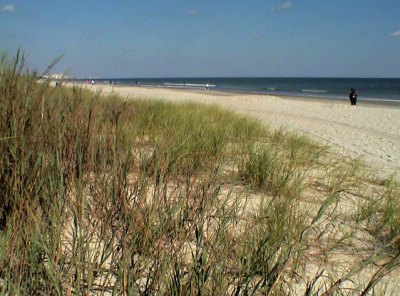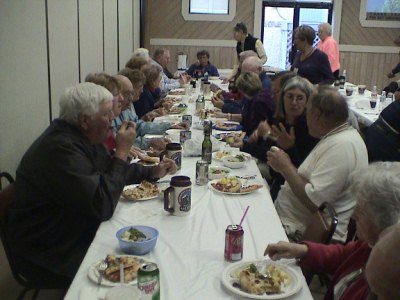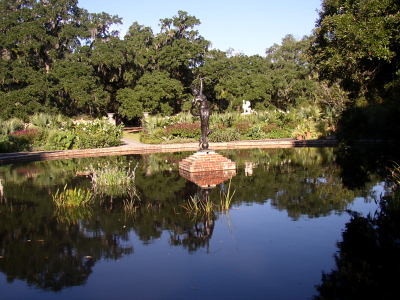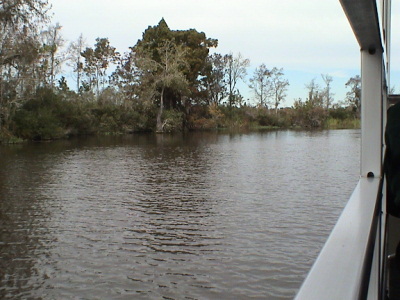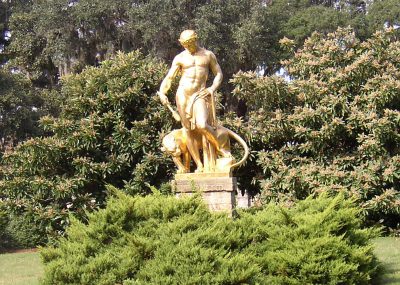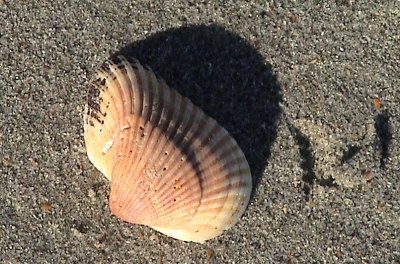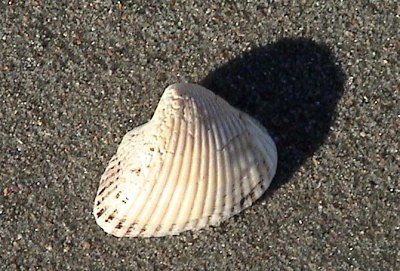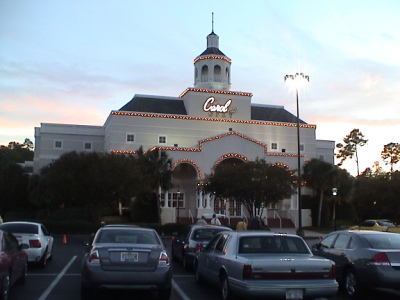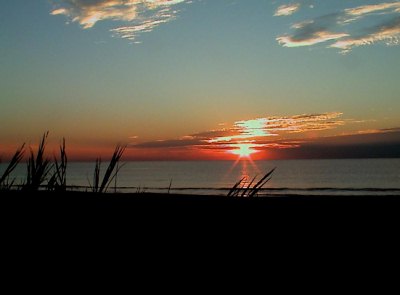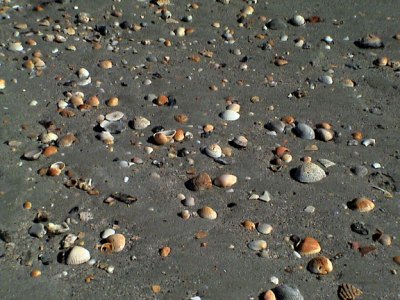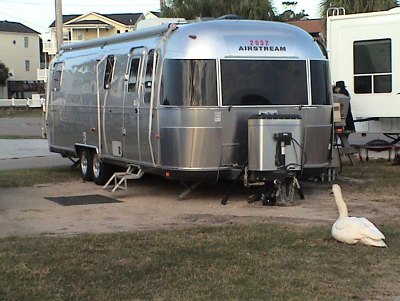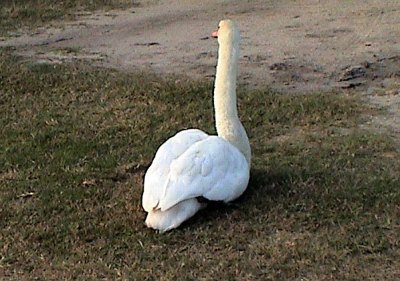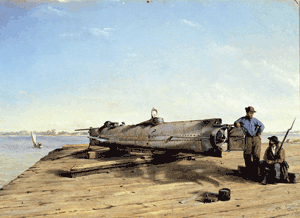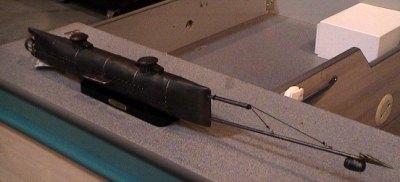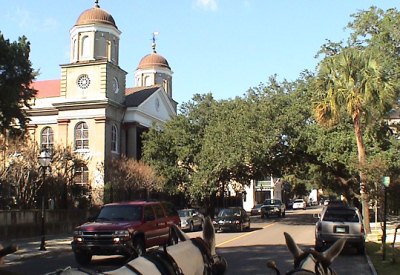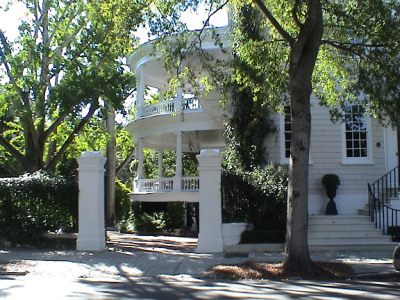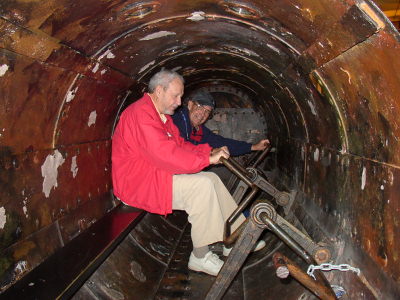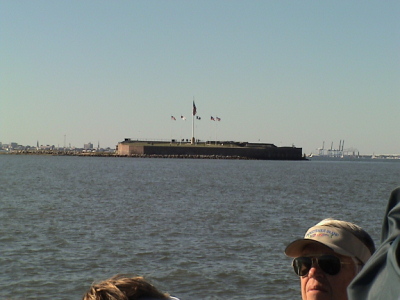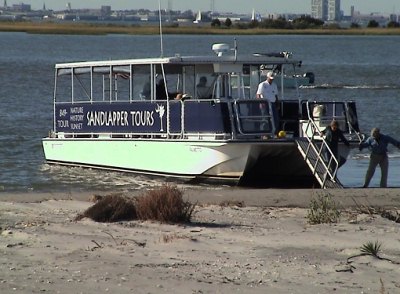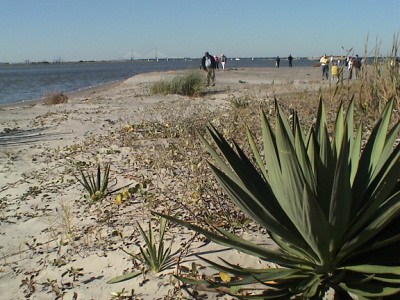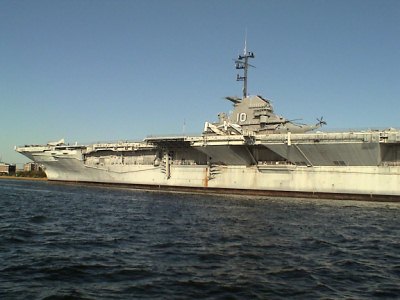October 24, 2006 - Moving day - to Myrtle Beach, South Carolina. Myrtle Beach could be called the golf capital of the world - both regular and miniature. There is an abundance of both. It could be also called the Branson of the east - lots of Branson type shows. It's certainly a touristy place. The name is derived from the Sweet Myrtle Tree, a waxy shrub native to the area. The natural beauty of the area is now largely blotted out by the concrete of motels and hotels, until one walks down to the beach. The beach is still the wide sandy edge of the ocean it always has been framed with sea oats.
Our campsite is about 50 feet from the beach. We can't see the water for the dunes, but it's only a short walk. Today's wind is from the west, flattening the waves. This is the calmest we've seen the ocean on the trip.
Fare for the evening was pizza and tossed salad prepared by fellow caravaners, the Johnsons and the Heads. It was a delicious break from an almost steady diet of seafood.
October 25, 2006 - Brookgreen Gardens was our destination of this day. Established in 1931 by an heir to the Huntington railroad fortune, Brookgreen Gardens is a 9200 acre park that combines horticulture, sculpture, a zoo, and a boat ride through old rice fields. Fifteen miles south of Myrtle Beach on U.S.17, this is one beautiful place. We had a group walking tour through the gardens with a volunteer guide who had been there for thirteen years and really knew his stuff. There are some 500 pieces of sculpture in unbelievable gardens. This was not the time of year for the many flowering shrubs to bloom, but we could see the potential with all the azaleas, hydrangeas, and other flowering plants. One of the most impressive spots was a grove of 200 year old live oak trees. We had a self-serve lunch, then boarded a pontoon boat for an hour-long narrated tour on the Brookgreen River. We saw the remains of the old rice fields and got a good description of the planting and harvesting procedures. This slave labor operation was abandoned after the Civil War and emancipation of the slaves. There are 70 paid employees at Brookgreen who, along with 300 volunteers, keep the gardens going.
Spent the afternoon relaxing and walking on the beach. Found very few shells. Most that were there were broken. I walked about a mile down the beach, finding only two half shells in tact. The beach was wide, and the water calm with the wind coming out of the west. There was a chill in the air.
After dinner with the Watters at the Bob Evans restaurant we joined the other caravaners at the Carolina Opry for an evening of entertainment. The varierty show ranged from good to excellent. The piano player from England was especially good as were a quartet of tap dancer/cloggers. Lighting and pyrotechnics were dramatic, while the sound was loud. The large auditorium was almost full, even though this was the off season.
October 26, 2006 - The sunrise over the Atlantic Ocean was spectacular this morning. Our leaders, Jamie and Susan, cooked breakfast for the caravan on this morning - French toast, sausage, bananas, and all the fixings. The rest of the day was free.
Lots of shells on the beach this morning - must have come in with the tide.
Walking on the beach was not as easy at high tide. Still plenty of white sand,
but so loose it makes walking hard. By afternoon at low tide all the shells
were gone again.
An errant swan flew in and settled next to the Johnsons' trailer. Just sat there
unperturbed for several minutes begging to have his picture taken.
October 27, 2006 - Now it was time to move on down the coast to Charleston. We awoke to a light rain which plagued us all the way. Our campsite was the KOA on Hwy 17 in the suburb of Mt. Pleasant. With all the rain there wasn't much to do but sit in the motorhome and relax after getting there. That evening the Wendts and Cooks prepared a chili supper for everyone which we enjoyed in the campground rec room.
October 28, 2006 - The first tour of our stay in Charleston was a visit to the Conservation Center where the H.L.Hunley submarine is being studied. This is the submarine which disappeared during the Civil War after sinking a warship. Lost at sea for 137 years, the Hunley was discovered on bottom of Charleston Bay by novelist Clive Cussler. It was raised in 2000 and now rests in a tank of fresh water in the Warren Lasch Conservation Center while a team of conservation experts take it apart piece by piece, gradually uncovering the mystery of why it sank. The Hunley has the distinction of being the first submarine to sink an enemy ship. After ramming the warship Housatanic, the U.S.Navy’s largest vessel of that time, the Hunley backed away and set off a charge that it had embedded in the side of the Housatanic. The Housatanic burned for three minutes and sank, Then, after signaling that it’s mission had succeeded, the Hunley disappeared. It disappeared along with the eight crewmen who sat in cramped quarters turnng a hand crank that powered the submarine through the water.
The irony of the event was that only five men were killed on
the Housatanic, while all eight of the Hunley crewmen lost their
lives. Still it marked the beginning of submarine warfare.
After lunch at the Bubba Gump Shrimp Co. we boarded three
mule-drawn buggies for a narrated tour of the city. Our buggy
was pulled by a matched pair of white mules. The buggy
driver talked non-stop about his city with many anecdotes.
He was obviously very knowledgable about the history of Charleston.
Following the buggy ride we toured the largest of the Charleston
mansions - the Calhoun mansion. This was one of the mansions
pointed out by the buggy driver. The 1830 building sat abandoned
and empty for several years, then was occupied by Naval offices for
several years. The 24,000 square foot, three story mansion was
purchased by a litigation attorney in 1976 and restored to its previous
grandeur. His furnishings bordered on clutter - all first class stuff - but
far in excess of what would have been necessary for a comfortable home.
October 29, 2006 - Another clear sky day and no wind, boding well for the boat ride scheduled for the afternoon. With the opportunity to attend church in the morning, we headed for the harbor to load the boat at 2:00pm. The "Sandlapper" sailed right on time - 2:00pm, cruising first just offshore along the battery. Those mansions look just as elegant from the water as from the street. We then headed out toward Fort Sumter. The air was so clear the old fort could be seen all the way. As we approached the narrator explained how the first shots of the Civil War were fired there, and how the fort was originally three times higher, but reduced to rubble by the bombardment during the war. Then we landed on the beach at Morris Island for a 30 minute break. Everyone spread out along the beach looking for shells, sand dollars, shark's teeth, etc. Morris Island was one of the places where the Union gun batteries were located. O. the way back to the dock we passed by for a close look at the the Yorktown aircraft carrier. All told, it was a very nice excursion in beautiful weather.
That evening we had icecream and cake to celebrate the birthdays of those caravaners who had birthdays during the caravan - George DeVaull, Jean Hecht, Alice Zitzer, and Herman Cook. It was followed by an interesting presentation on containerized shipping - how it has grown in the last 30 years and how it is projected to grow in the next fifteen.



